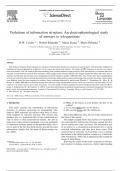Exam (elaborations)
Violations of information structure: An electrophysiological study of answers to wh-questions
- Course
- Institution
Violations of information structure: An electrophysiological study of answers to wh-questions H.W. Cowles a,*, Robert Kluender b , Marta Kutas b , Maria Polinsky b a University of Florida, Linguistics, P.O. Box 115454, Gainesville, FL 32611, United States b UC San Diego, United States Accept...
[Show more]



